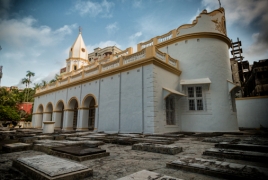
The late caretaker of the 18th century Armenian Church of Dhaka, Michael Joseph Martin, was the last Armenian living in Bangladesh, a country nestled in a region that has been home to a thriving Armenian community for hundreds of years. Martin’s death at the age of 89 has not only marked the end of an era, but has thrown into doubt the future of one of Dhaka's most beautiful churches.
The earliest surviving Armenian tombstone in Bangladesh dates back to 1714, which makes the known Armenian presence in Bangladesh to be over 300 years. But the story of how exactly the Armenians came to exist in the Muslim-majority country is as interesting as it sounds.
Bangladesh emerged as an independent nation in 1971 after achieving independence from Pakistan, which was, in turn, created during the Partition of India of 1947 (the division of British India into two independent states, India and Pakistan). And it was particularly East Bengal – the eastern half of the Indian region of Bengal – that later became the independent country of Bangladesh.
The earliest references to relations between Armenians and Indians are found in Xenophon’s Cyropaedia, which says that Armenians traveled to India as early as 430–355 BC. But it was not until the 16-17th centuries that a large number of Armenians (mostly from Persia, or present-day Iran, after Shah Abbas deported tens of thousands of Armenian traders to Persia) arrived in India at the invitation of Mughal emperor Akbar and settled in the city of Agra, where by the middle of the 19th century there was a sizable Armenian presence.
The Armenians expanded across India and reached Bengal (a part of which later became Bangladesh) in around 1645. The community in Dhaka, in particular, grew in size and influence and came to play a significant role in Bengali trade and commerce in the 17th and 18th centuries. In 1747, it was estimated that Armenian merchants were responsible for at least 23% of the textiles exported from Dhaka. The Armenians were the first to establish European-style grocery stores in Dhaka. There even is a neighborhood in Dhaka called Armanitola, which bears their name, while the Armenian Church of the Holy Resurrection and cemetery established by the community in 1781 are major landmarks.
Besides textile and raw silk, the Armenians also engaged in the trade of saltpetre (used as gunpowder), salt, and betel nut, and pioneered jute-trading in the second half of the 19th century. When they began to lose the textile business to the British traders in the late 18th century, they came to focus on landholding, eventually becoming prominent and wealthy zamindars (landowners).
While there is no certain data as to the number of Armenians living in the region in the various periods of time, most accounts agree that the assertive presence of Armenians began to decline from the beginning of British rule in the mid-19th century. The result was that the number of Armenians dwindled to such an extent that Martin remained the only Armenian living in Dhaka for at least the past 15 years. Now that he is gone, the Armenian community of Bangladesh is history.

